Car Review | The 5th Generation Honda Accord | Japan, North America and Australia (wagon and coupe only for Europe). In 1994, the Honda Accord was moved to yet a larger "CD" chassis, primarily to better suit the requirements of the North American market. It grew in width but oddly shrunk in length, leaving it classified as a mid-size car in North America. It thus became too wide to fit within the favorable tax bracket in Japan, where its role was to be partially taken over by the smaller second-generation Honda Ascot and Honda Rafaga. The engines offered also exceeded the maximum limit of 2000 cc to remain in the favorable tax bracket as well. Honda of Japan marketed four different size engines in the Japan-Spec Honda Accord Sedan:1.8, 2.0, 2.2 VTEC and 2.2 DOHC VTEC. The Japanese-spec Accord models were marketed as the following: EF, EX, 2.0EX, 2.0EXL, 2.2VTE, 2.2VTL, 2.2VTS and SiR.
DX, LX and EX remained the American trim lines while Canada retained the LX, EX and EX-R. The 5-speed manual transmission remained mostly unchanged, while the 4-speed automatic noted for its hard shifts, now included Honda's "Grade-Logic" shift program. All Accord models received a more ergonomic interior with standard safety features such as dual airbags and reinforced side-impact beams. Exclusive to the EX was the F22B1 SOHC VTEC version of previous generation 2.2-liter 4-cylinder (making 145 hp (108 kW) up from 140 hp (104 kW) on the previous generation EX), anti-lock brakes (now an option for the LX), 4-wheel disc brakes, 15" alloy wheels, and a rear stabilizer bar. Leather was an option in the EX trim with leather equipped models now being referred to as EX-L. DX and LX models came equipped similarly to the previous generation and were fitted with a revised version of the previous generation's 2.2 liter non-VTEC 4-cylinder engine. This F22B2 engine was rated at 130 hp (97 kW) up from 125 hp (93 kW) the previous generation. The Accord was again named Motor Trend Import Car of the Year for 1994. The Accord coupe as in the previous generation looked almost exactly like the sedan, and was the last generation of the Accord to offer a wagon variant in North America until the introduction of the Accord Crosstour in 2009.
Honda of Japan produced three high performance models of the Accord (sedans, coupes, and 96�97 wagons) for the Japanese market (JDM) referred to as the SiR model which was available for sale in Honda CLIO dealerships in Japan. The Honda Accord SiR models were not hard to tell apart from the Accord EX model; which came equipped with the Japan-spec H22A DOHC VTEC engine instead of F22B1 SOHC VTEC engine. The Japan-spec H22A DOHC VTEC engine specs were 190 bhp (142 kW; 193 PS) at 6800 rpm; peak torque 152 lb�ft (206 N�m) at 5500 rpm with a compression ratio of 10.6:1. The Japan-spec H22A DOHC VTEC engine was similar to the H22A1 engine found in the North America market used in the Prelude DOHC VTEC of the same era. The Japan-built Accord SiR Sedans (94�97) came available with a 5-speed manual transmission as standard equipment or an optional four-speed automatic transmission. The Honda of America-built (HAM) Accord SiR Coupes and then the 96�97 Accord SiR Wagons had the four-speed automatic transmission as standard equipment (5-speed manual transmission were not available for these two models). It came with cloth sport seats styled similar to the Prelude and had some power options found on the Accord EX. The Accord SiR Coupes (94�97) and the Accord SiR Wagons (96�97) were exclusively available for the Japanese market (JDM). Honda Accord SiR chassis codes for the sedan were the CD6, the coupe-CD8 and the 96�97 wagon-CF2. The Accord SiR Coupes and the Accord SiR wagons (96-97) which were exclusively built in the U.S. at Honda's Marysville Ohio plant (HAM) but were marketed for Japan export only for this particular model was not offered in North America. The Accord SiR Coupes and then the Accord SiR Wagons were built with the Japan-spec H22A DOHC VTEC powertrains which were shipped from Japan and were installed into the HAM-built Accord SiR models. The 1994�1997 "CD" Accord chassis was designed for the H22A DOHC VTEC powertrain to be installed; because the firewall was curved at the top to allow more space for the tilting backwards of the H22A DOHC VTEC engine near the middle of the firewall. The H22A DOHC VTEC engine was the most powerful inline four cylinder engine Honda built for the Prelude and the Accord before the 1995 U.S.-spec V6 sedan. The Accord SiR suspenion was improved with stiffer front swap bar(27.2mmXt4.0mm), stiffer rear swap bar (16 mm), stiffer front coil springs and stiffer rear coil springs. Features for the 94�95 Accord SiR models (sedans and coupes) included the following items: cruise control, automatic climate control (Similar to the first generation Acura CL), Bose stereo system, 7,400 redline tachometer, optional electronic traction control and optional limited slip differential for automatic transmission, optional SRS and airbags, factory installed driving lights, optional factory installed "pop up" navigation radio head unit, sound insulation liner under front hood, black housing front headlights, no side molding was available on the Accord SiR sedan, optional sunroof and power retractable outside mirrors. Features for the 96�97 Accord SiR models (sedans, coupes and wagons) included the same as above while adding; optional cruise control, rear window wiper on the sedan, optional leather interior and a colored side molding for the sedan as well.
In 1995, the Accord debuted a V6 engine, the 2.7L C27 borrowed from the first generation Acura Legend, in the U.S. market. The V6 was offered in both the LX and EX versions of the sedan, LX models being referred to as LX-V6 and EX models as EX-V6. EX-V6 models came equipped similarly to the EX-L with leather seats being the only option in the EX-V6. Addition of the taller C27 engine required substantial alterations to the CD platform, with V6 models sporting a redesigned engine layout, taller front fenders, and a different hood than I4 models; however, these differences are difficult to spot without both models parked side-by-side. Both versions of the V6 received a dual-outlet exhaust, a 4-speed automatic transmission, 15" machined aluminum alloy wheels on the EX-V6 and 15" steel wheels with full covers on the LX-V6, and a slightly updated front grille. The Accord saw very few other changes in 1995 with the exception of a few different exterior and interior color combinations.
In 1996, Honda Accord underwent the usual mid-generation facelift. More rounded bumpers, a slightly modified front fascia with new signal lights and rear taillights gave the Accord a softer look. All Hondas now complied with the federal government's requirement of OBD II engine diagnostics though all three engine choices remained the same. In order to increase the Accord's competitiveness against its rivals in different international markets, Honda CEO Nobuhiko Kawamoto decided on one basic platform for the sixth-generation Accord, but with different bodies and proportions for local markets. In the U.S. the 1996 model lineup included the 25th Anniversary Edition, a model positioned between the DX and LX.
In 1997, Honda released the "Special Edition" version of the Accord (not to be confused with the SE). It was offered in three colors: Heather Mist Metallic, San Marino Red and Dark Currant Pearl. The Special Edition received a factory installed security system with keyless entry, single-disc CD player, body colored side molding, distinctive alloy wheels and a sunroof. It was offered in an automatic transmission only and was fitted with the same engine as the LX.
In New Zealand, the 5th generation Honda Accord was assembled at Honda's manufacturing site in Nelson and was released in March, 1994. It was available in LXi, EXi and EXi-S trim levels. A facelift was released in December 1995, which coincided with the release of VTEC engines in the upper-spec models. Trim levels were LXi, VTi, and VTi-S. These were the first NZ-market Accords to have airbags � two in the VTi-S, one in the VTi. - Car Review
The 5th Generation Honda Accord








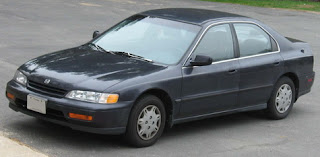
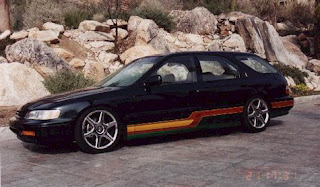
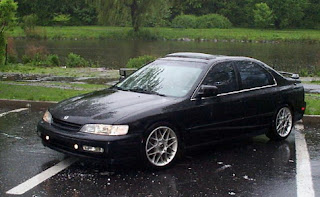
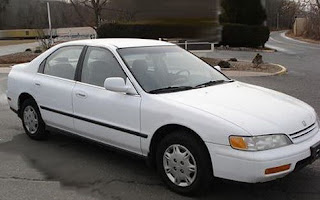
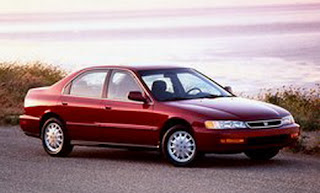
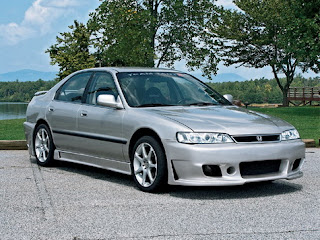
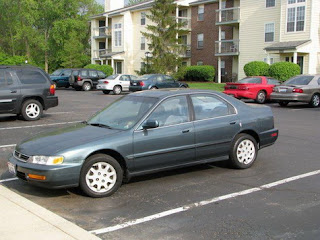


No comments:
Post a Comment